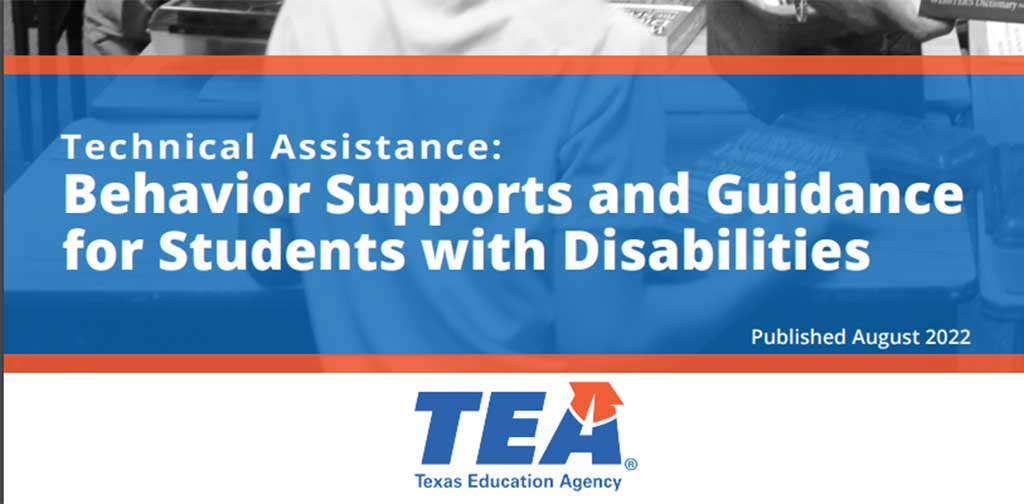A new “To The Administrator Addressed Correspondence” letter has been posted on the TEA website:
February 26, 2018
TO THE ADMINISTRATOR ADDRESSED:
SUBJECT: Responsibilities and Timelines Regarding Parent Requests for Special Education Evaluations under the Individuals with Disabilities Education Act (IDEA), the Texas Education Code (TEC), and the Texas Administrative Code (TAC).
In late 2016, the U.S. Department of Education’s Office of Special Education Programs (OSEP) initiated visits to Texas to learn about referral, child find, and evaluation practices within the state’s special education system. On January 11, 2018, OSEP released a final monitoring report detailing its findings1
The purpose of this letter is to:
1. Provide a brief overview of OSEP’s findings
2. Articulate and confirm obligations mandated under IDEA
3. Provide information related to TEA’s next steps
We encourage all local educational agencies (LEAs) to review OSEP’s findings and consider the potential implications for their communities.
OSEP’s Findings
Federal officials examined special education enrollment data, held five listening sessions with diverse stakeholders, and conducted twelve on-site district visits. As a result, OSEP identified three areas of noncompliance under IDEA.2
1. “TEA failed to ensure that all children with disabilities residing in the State who are in need of special education and related services were identified, located, and evaluated, regardless of the severity of their disability, as required by IDEA section 612(a)(3) and its implementing regulation at 34 C.F.R. §300.111.
2. TEA failed to ensure that [a free appropriate public education (FAPE)] was made available to all children with disabilities residing in the State in Texas’s mandated age ranges (ages 3 through 21), as required by IDEA section 612(a)(1) and its implementing regulation at 34 C.F.R. §300.101.
3. TEA failed to fulfill its general supervisory and monitoring responsibilities as required by IDEA sections 612(a)(11) and 616(a)(1)(C), and their implementing regulations at 34 C.F.R. §§300.149 and 300.600, along with 20 U.S.C. 1232d(b)(3)(A), to ensure that ISDs throughout the State properly implemented the IDEA child find and FAPE requirements.”
Summary of LEA Responsibilities
LEAs are responsible for identifying, locating, and evaluating all students who are potentially eligible for special education and related services.3 An LEA’s child find duty to seek parental consent to evaluate a child when it suspects or has reason to suspect that the child has a disability and needs special education services is an affirmative one; a parent is not required to request that the LEA identify and evaluate the child. However, a parent may request an initial evaluation at any time if the parent believes that his or her child is a child with a disability in need of special education and related services.4
If a parent submits a written request for an initial evaluation to an LEA’s director of special education services or to an LEA administrative employee, the LEA must, by the 15th school day following the date of receipt of the request, provide the parent either: 1) prior written notice of its proposal to conduct an evaluation, a copy of the Notice of Procedural Safeguards, and the opportunity to give written consent for the evaluation; or 2) prior written notice of its refusal to evaluate, including an explanation of why the LEA refuses to conduct an initial evaluation and the information that was used as the basis for the decision, as well as a copy of the Notice of Procedural Safeguards.5
If the LEA proposes to conduct an initial evaluation, the LEA must obtain written, parental consent and should promptly complete the initial evaluation report. The LEA must complete the initial evaluation report no later than the 45th school day following the date parental consent is received except in specific situations as outlined in TEC §29.004 and 19 TAC §89.1011(c) and (e).
If, however, the LEA denies the request for an initial evaluation, the parent can challenge this decision by requesting a due process hearing6 or filing a state complaint7 to resolve the dispute regarding the child’s need for an evaluation, as explained in the Notice of Procedural Safeguards, which the LEA is required to provide to parents.8 A third party may also file a special education complaint9 to address the LEA’s refusal to evaluate the child for special education eligibility. A parent and an LEA may also agree to engage in no-cost mediation to attempt to resolve their dispute.10
As a reminder, it would be inconsistent with IDEA’s evaluation requirements for an LEA to reject a referral and delay provision of an initial evaluation on the basis that a child has not participated in a Response to Intervention (RtI) framework.11
Child Find Obligations under IDEA
Child Find Background12
Central to IDEA and its implementing regulations is the requirement that all states have policies and procedures in place to ensure that all children with disabilities within the state who are in need of special education and related services are identified, located, and evaluated.13 This duty, referred to as “child find,” includes children with disabilities who are:14
- Homeless;
- Wards of the state;
- Attending private schools;
- Highly-mobile; and/or
- Suspected of being a child with a disability and in need of special education, even if they are advancing from grade to grade.
IDEA defines children with disabilities as those children who:
- Have been properly evaluated and determined as having an intellectual disability, a hearing impairment, a speech or language impairment, a visual impairment, a serious emotional disturbance, an orthopedic impairment, autism, traumatic brain injury, an other health impairment, a specific learning disability, deaf-blindness, or multiple disabilities; and
- Require special education and related services as a result of the disability.15
A child who has one of the above-mentioned disabilities is not a child with a disability under IDEA if:
- the child does not require special education and related services due to the disability, or
- the child requires a related service only.16
An LEA’s failure to meet IDEA’s child find requirements is a serious matter that could result in denying FAPE to a child who is eligible for special education services. Furthermore, the failure to identify a child may entitle the child to compensatory education or tuition reimbursement.
Dyslexia and/or Related Disorders
Though the child find mandate applies to students with dyslexia and/or related disorders, OSEP found systemic IDEA violations related to this population. Dyslexia is a lifelong disability that manifests differently in individuals. The disability is generally characterized by an insufficient ability to read, spell, and link letters to sounds. Many students who struggle with dyslexia also grapple with co-occurring disorders, such as dysgraphia, dyscalculia, and ADHD.
In its report, OSEP found that students with dyslexia are often evaluated and accommodated under Section 504 of the Rehabilitation Act regardless of students’ potential need for specialized instruction under IDEA.17 LEAs are reminded that, if a student is suspected to have dyslexia and/or a related disorder and a need for special education services, they must refer the student for an initial evaluation in accordance with 34 C.F.R. §§300.300-300.311. LEAs may not deny an initial evaluation or special education services to a student with dyslexia and/or related disorders because he or she does not present a second, potentially disabling condition.
This spring, under the direction of the State Board of Education, TEA will partner with stakeholders to update the Dyslexia Handbook to clarify IDEA requirements as they relate to screening, evaluating, and serving students with dyslexia and/or related disorders.
Response to Intervention Strategies18
As stated in the Parent’s Guide to the Admission, Review, and Dismissal Process, a child does not need to advance through each tier of an RtI system before a referral for special education is made.19 Furthermore, OSEP has advised that it would be inconsistent with the evaluation provisions of IDEA for an LEA to reject a referral and delay an initial evaluation on the basis that a student has not participated in an RtI framework.20 Once it is apparent that general education interventions are not sufficient to address a student’s difficulty in the general classroom, LEA personnel must initiate a referral.21
LEAs are reminded that parents may also request a referral at any time regardless of whether the child is receiving interventions through the RtI framework.22 OSEP has advised that, unless an LEA believes there is no reason to suspect that a child has a disability and is in need of special education services, an evaluation must be conducted within the applicable timeline.23 If, however, an LEA does not suspect that the child is a child with a disability and denies the request for an initial evaluation, the LEA must provide written notice to the child’s parents explaining why the LEA declines to conduct an initial evaluation and the information that was used as the basis for that decision.24 The parent may then challenge this decision by requesting a due process hearing under 34 CFR §300.507 or filing a complaint under 34 CFR §300.153 to resolve the dispute regarding the child’s need for an evaluation.
LEAs are also reminded that the 85th Texas Legislature passed Senate Bill (SB) 1153 to improve outcomes for struggling learners receiving services through intervention strategies, including the RtI process. Accordingly, during each school year when a child begins receiving assistance through the RtI process, LEAs must provide the child’s parents with written notice containing the following information.25
1. A reasonable description of the assistance that may be provided to the child, including any intervention strategies that may be used;
2. Information collected regarding any interventions in the base tier of a multi-tiered system of supports that has previously been used with the child;
3. An estimate of the duration for which the assistance, including through the use of intervention strategies, will be provided;
4. The estimated time frames within which a report on the child’s progress with the assistance, including any intervention strategies used, will be provided to the parent; and
5. Information about the parent’s right to request, among other things, a special education evaluation at any time.
6. The notice must be written in English or, to the extent practicable, the parent’s native language.
TEA developed a model notice that LEAs may use to fulfill the law’s requirements. The notice, an updated Student Handbook Statement for providing assistance to students who have learning difficulties or who need or may need special education, and a Frequently Asked Questions (FAQ) document on SB 1153, can be found on TEA’s website at https://tea.texas.gov/Academics/Special_Student_Populations/Special_Education/Programs_and_Services/Response_to_Intervention/.
Minimum Records Retention Periods
LEAs are subject to mandatory minimum retention periods for various records. For example, LEAs are required to retain special education records for at least five years per Local Schedule SD (revised 2d ed.) under 13 Tex. Admin. Code Chapter 7, Subchapter D. LEAs are reminded that these are minimum state requirements. While the corrective action plan is developed, it is prudent for LEAs to consider whether the records of certain students should continue to be retained. Preserving records beyond the minimum retention period for students who potentially needed services and either have not yet received them or received them on a delayed basis will likely assist in fulfilling the corrective action plan upon final adoption.
TEA Next Steps
TEA will finalize a corrective action plan in April 2018. As outlined in its letter to TEA, OSEP must receive the following in the plan.26
1. “Documentation that the State’s system of general supervision requires that each ISD identifies, locates, and evaluates all children suspected of having a disability who need special education and related services, in accordance with section 612(a)(3) of the IDEA and its implementing regulation at 34 C.F.R. §300.111, and makes FAPE available to all eligible children with disabilities in accordance with section 612(a)(1) of the IDEA and its implementing regulation at 34 C.F.R. §300.101.
2. A plan and timeline by which TEA will ensure that each [LEA] will
a. Identify, locate, and evaluate children enrolled in the [LEA] who should have been referred for an initial evaluation under the IDEA; and
b. Require individualized education program (IEP) Teams to consider, on an individual basis, whether additional services are needed for children previously suspected of having a disability who should have been referred for an initial evaluation and were later found eligible for special education and related services under the IDEA, taking into consideration supports and services previously provided to the child.
3. A plan and timeline by which TEA will provide guidance to [LEAs] in the State, including all general and special education teachers, necessary to ensure that [LEAs]
a. Ensure that supports provided to struggling learners in the general education environment through RtI, Section 504, and the State’s dyslexia program are not used to delay or deny a child’s right to an initial evaluation for special education and related services under the IDEA;
b. Are provided information to share with the parents of children suspected of having a disability that describes the differences between RtI, the State dyslexia program, Section 504, and the IDEA, including how and when school staff and parents of children suspected of having a disability may request interventions and/or services under these programs; and
c. Disseminate such information to staff and the parents of children suspected of having a disability enrolled in the [LEA’s] schools, consistent with 34 C.F.R. §300.503(c).
4. A plan and timeline by which TEA will monitor [LEAs’] implementation of the IDEA requirements described above when struggling learners suspected of having a disability and needing special education and related services under the IDEA are receiving services and supports through RtI, Section 504, and the State’s dyslexia program.”
The corrective action plan submitted to OSEP will describe actions TEA will take to meet the requirements listed above.
Ongoing Feedback Opportunities
There have been and continue to be ongoing opportunities for all stakeholders to provide feedback on the corrective action plan and on the larger strategic vision for special education. These include:
- On January 18, 2018, TEA submitted a draft corrective action plan to Governor Abbott.27
- Over 100 stakeholder meetings were scheduled throughout the month of February in each of the twenty established regions in the state at both Education Service Centers (ESCs) and at LEAs.
- Stakeholders had the opportunity to provide feedback on the initial draft in an online survey through February 20, 2018.
- Stakeholders have the opportunity to provide ongoing feedback through the official email address: TexasSPED@tea.texas.gov.
- On or about March 5, 2018, TEA will release its proposed corrective action plan as part of the SPED Strategic Plan.
- Stakeholders may provide feedback on the proposed plan during an additional comments period, which will run through March 31, 2018. Feedback during this period should be submitted to TEA in writing using the email address noted above.
- In April, TEA will submit its final corrective action plan to OSEP and will also publish a Special Education Strategic Plan.
For information about how TEA is engaging parents, educators, administrators, school boards, and other stakeholders in the plan’s development, see page 13 of TEA’s initial draft corrective action plan and/or visit the website at www.tea.texas.gov/TexasSPED/.
Questions regarding this information should be directed to TEA’s Department of Special Populations, Division of Special Education:
Phone: 512-463-9414
Email: sped@tea.texas.gov
Thank you for your attention to this critical work and for our shared commitment to serving and supporting students in the state of Texas.
Sincerely,
Penny Schwinn
Chief Deputy Commissioner, Academics
- U.S. Department of Education (USED), Office of Special Education Programs (OSEP), Texas Part B Monitoring Visit Letter (Jan. 11, 2018), https://www2.ed.gov/fund/data/report/idea/partbdmsrpts/dms-tx-b-2017-enclosure.pdf
- See, Texas Part B Monitoring Visit Letter, supra, page 13
- 34 CFR §300.111
- 34 CFR §300.301(b)
- 34 CFR §300.503, TEC §29.004, and 19 TAC §89.1011(b)
- 34 CRF §300.153
- 34 CFR §§300.151-153
- 34 CFR §§300.503 and 504, TEC §29.004(c), and 19 TAC §89.1011(b)
- 34 CFR §§300.151-153
- 34 CFR §300.506
- 34 CFR §§300.301 through 300.111
- TEA provided similar guidance in a Nov. 17, 2016, letter to administrators. See https://tea.texas.gov/About_TEA/News_and_Multimedia/Correspondence/TAA_Letters/Reminder_about_Important_District_Responsibilities_under_the_Individuals_with_Disabilities_Education_Act/
- 34 CFR §300.111(a)(i)
- 34 CFR §300.111(a)(i) and (c)
- 34 CFR. §300.8
- 34 CFR §§300.8(a)(2) and 300.306(b)(2)
- See Texas Part B Monitoring Visit Letter, supra,, pages 10-12.
- TEA provided similar guidance in a Nov. 17, 2016, letter to administrators. See https://tea.texas.gov/About_TEA/News_and_Multimedia/Correspondence/TAA_Letters/Reminder_about_Important_District_Responsibilities_under_the_Individuals_with_Disabilities_Education_Act/
- Texas Education Agency, Parent’s Guide to the Admission, Review, and Dismissal Process (April 2016): 2, https://framework.esc18.net/Documents/ARD_Guide_ENG.pdf
- M. Musgrove to State Directors of Special Education, OSEP Memorandum No. 11-07 (Jan. 21, 2011), https://www2.ed.gov/policy/speced/guid/idea/memosdcltrs/osep11-07rtimemo.pdf
- 19 TAC §89.1011(a)
- 34 CFR §300.301(b)
- See footnote 13
- 34 CFR §300.503(a) and (b)
- TEC §26.0081(d)
- See Texas Part B Monitoring Visit Letter, supra, page 14
- Texas Education Agency, TEA Proposed Initial Draft Plan: U.S. Department of Education Corrective Action Plan Request (Jan. 18, 2018): https://tea.texas.gov/texassped/



